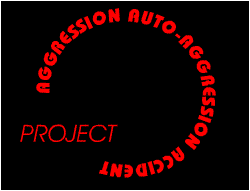 target
name: STEPHANIE BENZAQUEN
target
name: STEPHANIE BENZAQUEN target
name: STEPHANIE BENZAQUEN
target
name: STEPHANIE BENZAQUEN
|
STATEMENT For this project, I would like to
point out the moment and place of switch. There are a lot of variants
of the switch, like the two aspects of the same conflict. Let’s
deal with the space of confusion where the victim becomes an executioner,
or the opposite and with the symbols and myths – because there
are not historical or political real facts that can open to it –
that translate this switch. It is par excellence the moment of trauma
or of post-traumatic syndromes. In the case of Israel, the Holocaust
is the optimal confusion and the absolute “myth” that allows
our present situation. Israel was founded on the genocide’s basis.
Israel is a country of survival: the people that created it and developed
it are connected to the Holocaust, the State they created is most of
the time in position of surviving or, more exactly, needs to see itself
in such a position. Thus, a vicious circle was built. If the Holocaust
is the basis of an identity construction and of the people definition,
therefore it becomes a model of identity. The Arab (Palestinian and
Israeli Arabs) claim for their own massacre in order to build their
country. They refer to the “Nakba”, the day they were expelled
in 1948 by the Israeli army. It sounds totally crazy, but it’s
a fact: the destruction is a matrix. The game is never over. Exponential
increasing: a terrorist attack leads to a military answer, a military
answer leads to a few terrorist attacks and a few terrorist attacks
lead to many military answers…Etc. The trauma nourishes itself: you have
to blame the others for a situation that you maintain. The survival
has no past and no future. It keeps itself up in a very specific present,
therefore in a deadlock. The aggression against the environment is the
impossibility of going away and of leaving or correcting the situation:
it’s an auto-aggression. The Holocaust and its visual expression,
the camp, have marked us for generations. The camp – concentration
camp, transit camp or ghetto – is the architectonic model of the
trauma. And it will be the solution for each conflict. Building a barrier,
a wall between two populations is not a fair partition of the same earth
but the possibility of continuing the same conflict for years. We just
deport the war. Protection will be the justification of aggression acting
without the necessary understanding that we run to catastrophic consequences.
The competition of the victims opens the door to a locking-up and to
its apparatus, different kinds of what may be called nationalism. The
disappearance of a questioning regarding the good work of a democratic
system is the consequence of the disappearance of the possibility of
thinking in multiple dimensions. If the Holocaust is the obliged reading
grid for our present reality (we remain victims and have to organize
our own protection because every country wants our death or we, as victims,
didn’t understand the lessons of the past and we are now acting
as Nazis regarding the Arab population: those are the main directions
of the reading), thus we will stay in confusion. Israeli art has developed itself on
this basis. I will let aside for the moment the consequences of the
lack of distance in the relationships between art and politics. We’ll
consider the artistic practices trying to translate the disturbed /
confused feeling of “home”, the consequences of the conflicts
on the daily situation and on the position that each one has to give
to oneself and to the Other and different concepts as nationalism, fascism,
immigration, xenophobia. The proposed artists deal with the
mentioned issues: identity, position, home, otherness, memory, history,
conflict. |
||||